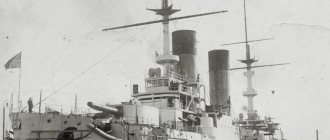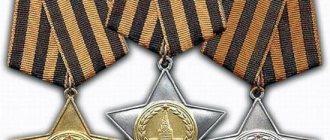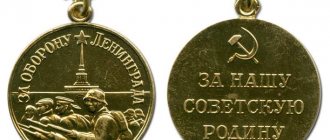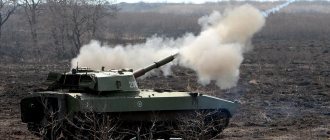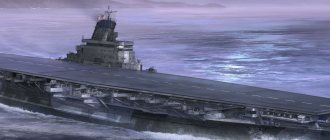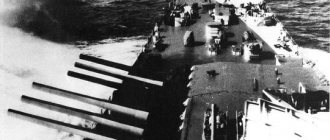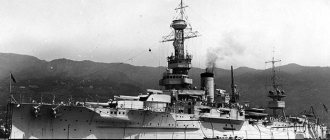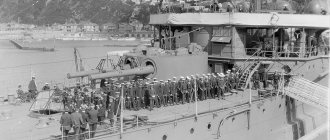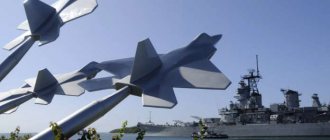Four battles of “Glory”, or the Efficiency of mine and artillery positions (part 1)
It is known that there are two polar points of view on the actions of the battleship (squadron battleship) “Slava” during the battles in Moonsund during the First World War.
Many sources call the battle path of this battleship heroic. However, there is another opinion “on the Internet” - that the battleship was used ineffectively, moreover, during the entire battle it never hit anyone, and therefore did not do anything heroic. In addition, the actions of the battleship "Slava" periodically become the focus of discussions of a different kind. For a long time, supporters and opponents of the “big fleet” have been debating what would be more effective for the Russian Empire - the creation of linear squadrons capable of defeating the enemy in a general battle, or the construction of relatively small battleships or monitors designed for defense on mine-artillery positions.
In the series of articles we bring to your attention, we will try to figure out how the battleship “Slava” performed in battles with the Kaiser’s fleet and how justified such a form of naval combat as the defense of a mine-artillery position is.
The Russian battleship met with superior German forces four times at mine and artillery positions: three times in 1915 and once in 1917, and the last meeting turned out to be fatal for the Slava. Let's look at these “meetings” in more detail.
In 1915, the Admiral Staff concentrated enormous forces in the Baltic Sea: 8 dreadnoughts and 7 old battleships, 3 battleships and 2 armored cruisers, 7 light cruisers, 54 destroyers and destroyers, 3 submarines, 34 minesweepers, a minelayer and auxiliary ships. With these forces, the Germans were going to carry out a large-scale operation in the area of the Moonsund archipelago, defended by the Russians.
The operation pursued three goals: 1) Support of German troops advancing in the direction of Riga. To this end, the fleet had to cross the Irbene Strait and invade the Gulf of Riga, from where German ships could support the coastal flank of the advancing army. 2) Prevent the Russian fleet from supporting its army. To do this, it was planned to destroy the Russian naval forces in the Moonsund archipelago and set up a minefield in the strait connecting the Gulf of Finland and the Gulf of Riga. This strait was too shallow for dreadnoughts, but quite sufficient for the passage of gunboats, destroyers and cruisers. Having blocked it, the Germans did not have to fear the impact of Russian naval artillery on their ground forces in the battles for Riga and the mouth of the Dvina. 3) Destruction of the main forces of the Baltic Fleet. It was assumed that the most modern and powerful German ships (dreadnoughts and battlecruisers) would not take part in the assault on the Irben Strait - they planned to send the old battleships of the 4th squadron there. They would act as bait, because they would give the Russians a great temptation to take out to sea their only brigade of dreadnoughts (four Sevastopol-class battleships), which could easily crush the old German ships. But in this case, 11 battleships and battlecruisers of the High Seas Fleet would have been waiting for them, and it would not have been difficult for them to cut off the Russians’ escape route to the Gulf of Finland and then destroy them. This, in the opinion of the Admiral Staff, would put an end to any active actions of the Russian fleet in the Baltic - not that they were so effective in 1914 - early 1915, but they were still quite annoying to the Germans.
In accordance with the above, only the 4th squadron was sent to break through the Irben Strait, which included, in addition to minesweepers and a minelayer, 7 old pre-dreadnought battleships, accompanied by light cruisers and destroyers.
For the Russian command, this plan was not a surprise; they knew about it and were preparing to counteract it. But in Moonsund there were only light forces and it was clear that they would not repel such a large-scale invasion. Therefore, it was decided to send a heavy ship to their aid, which would become the “core” of Moonsund’s defense. There wasn't much to choose from: there was no point in risking the dreadnoughts by driving them into the mousetrap of the Gulf of Riga. As for the battleships, the benefits of ships of the type “Andrew the First-Called” were not much greater than those of the “Slava” or “Tsesarevich”, despite the fact that the latter, having a smaller draft, would have felt much more confident among the shallow waters of the Moonsund archipelago.
Battleship "Slava" in the 1914-15 campaign
As a result, the choice fell on “Slava” and the battleship, under the cover of fleet ships, made the transition to Moonsund. Since the draft did not allow the ship to go to the Gulf of Riga directly from the Finnish ship, it had to take a detour through the Irbe Strait (the fairway through which the battleship passed was immediately mined). Now the naval forces of the Gulf of Riga included one battleship, four gunboats, a division of old destroyers, four submarines and a minelayer. Together with the crew of the Slava, the flagship artilleryman of the 2nd battleship brigade, Lev Mikhailovich Galler, also went to Moonsund.
First battle (July 26, 1915).
At dawn (03.50) the Germans began trawling the Irben Strait in its middle part - the pre-dreadnoughts Alsace and Braunschweig, as well as the cruisers Bremen and Tethys, provided immediate cover for the mine sweeping caravan. The remaining five battleships of the 4th squadron stayed further to the sea.
The gunboats "Threatening" and "Brave" were the first to open fire on the enemy, but were immediately driven away by the main caliber of German battleships. However, the good news for the Germans ended there - they got stuck in minefields and had three ships blown up, of which the T-52 minesweeper immediately sank, and the Tethys cruiser and the S-144 destroyer were forced to stop hostilities - their Germans had to tow “to winter quarters.” At approximately 10.30 "Slava" arrived. It would seem that a lot of blood is about to be shed. Many of those who have studied the history of the Russian Imperial Navy remember the battle of the Black Sea battleships with the German battle cruiser Goeben, when our gunners achieved hits from a distance of 90 and even 100 cables, so why should it have happened differently in the Baltic?
But alas - if for the Black Sea battleships, which were to shell Turkish fortresses in the Bosphorus, the elevation angle of the 305-mm guns was brought to 35 degrees, at which their 331.7 kg shells flew at 110 kbt, then for the Baltic battleships only 15 degrees of vertical aiming, which, with the same guns and shells, limited their firing range to 80 kbt. The Slava, whose guns were shot pretty hard, had an even lower maximum firing range - only 78 kbt. And the German battleships, whose main caliber was formally even somewhat inferior to the Slava (280 mm versus 305 mm), had an elevation angle of 30 degrees, which made it possible to fire 240 kg shells at a distance of over 100 kbt.
The advantage in range was immediately felt - “Slava” was fired at from a distance of 87.5 kbt. It is psychologically difficult to be under fire and not shoot back, but the Russian battleship did not open fire - there was no point in demonstrating to the enemy the true range of its guns. However, it was undesirable to expose oneself to the blows of even shells falling at a significant angle, and therefore, after the German battleships fired six salvoes at the Slava, the battleship retreated beyond the range of their fire.
Battleship "Brunschweig" - the enemy of "Glory" in the battle on July 26
In this battle, “Slava” had no damage. According to the testimony of midshipman K.I., who served on the battleship. Mazurenko:
“During the shelling, small fragments of 11-inch German shells fell like peas onto her decks when they exploded on the water, without causing any harm to either the ship or its personnel, because the decks were empty in battle"
This, in essence, was the end of Slava’s participation in the battle on July 26th. The Germans continued to mine the barriers of the Irbensky Bay without stopping, they managed to get through two strips of mines, but after that, by 13.00 they ran into a third barrier. This density of minefields shocked the German command to a certain extent; they were simply not ready for such a turn of events. There was practically no chance of trawling a passage into the Gulf of Riga in one day, and coal reserves (most likely on minesweepers) were coming to an end. Therefore, the commander of the German forces, Erhard Schmidt, gave the order to curtail the operation and retreat - it became clear to him that crossing the Irben Strait would require much more serious preparation.
Shortly after 13.00, the ships that crossed the Irben Strait received orders to retreat, but this did not save them from losses - at 14.05 the minesweeper T-58 was hit by mines and sank. And then the Germans left.
What conclusions can be drawn from the results of the battle on July 26, 1915? For the first time in its history, the Kaiserlichmarine encountered strong minefields, which it tried to force, but it turned out that the minesweepers involved were not enough. This in no way indicated the inability of the German fleet to carry out such operations - it was a banal lack of experience that let them down, and the Germans quickly learned from their mistakes.
As for the Slava, its appearance had only a psychological effect - the Germans saw that they were opposed by a single Russian battleship, and made all sorts of guesses as to why the ship did not open fire and enter the battle. Perhaps the presence of "Slava" became an additional argument in favor of stopping the operation, but one thing is certain - this time the German squadron was stopped by dense minefields that blocked the Irben Strait, but not by the defense of these barriers by the fleet.
Nevertheless, the psychological effect of the presence of a heavy Russian ship, ready to engage in battle under the cover of mines, turned out to be very great. The commander of the German naval forces in the Baltic (E. Schmidt commanded the ships at sea), Grand Admiral Prince Heinrich, attributed great moral significance to the destruction of the Slava, and even the Kaiser himself demanded that the Russian battleship be sunk by “submarines.”
Second battle (August 3, 1915)
The Germans made their next breakthrough attempt only a week later. At the same time, the composition of the breakthrough group, which was to pave the way to the Gulf of Riga, underwent qualitative changes - instead of the old battleships of the 4th squadron, the dreadnoughts Nassau and Posen were to take over. The rhombic arrangement of the 280-mm main-caliber artillery on these battleships can hardly be considered optimal, but the ability to fire in any direction (including straight ahead) from at least six barrels (at sharp heading angles - from eight) gave two such ships an overwhelming advantage over the Slava in an artillery battle, even if the distance between the opponents would allow the Russians to fire.
The main caliber of the battleships Alsace and Braunschweig, which came under fire from the Slava on July 26, were 280-mm SK L/40 cannons, firing 240-kg shells with an initial speed of 820 m/sec, while on " Nassau" and "Posen" were equipped with more modern 280-mm SK L/45 guns, which fired 302-kg shells at a speed of 855 m/sec. Four 305-mm cannons of the Slava fired 331.7 kg shells with an initial speed of 792 m/sec. Thus, the guns of the dreadnoughts in their combat capabilities came very close to the main caliber of the Slava, but if the Russian battleship could fight with two or four 305 mm guns, then the Nassau and Posen together could fire from 12-16 280 -mm guns, surpassing the Russian battleship in the number of barrels by 3-4 times. As for the firing range of German dreadnoughts, information about it varies in various sources, but in any case it exceeded 100 kbt.
The Russians also tried to prepare for future battles. The biggest problem with the Russian ship was the insufficient range of its guns, and something had to be done about it. Of course, there was no opportunity to modernize the gun turrets by increasing the vertical aiming angle directly in Moonsund, but L.M. Haller proposed another option - to take water into the battleship’s hull and thereby create an artificial roll of 3 degrees. This was supposed to increase the range of Russian guns by 8 kbt. Why did you stop at exactly three degrees?
Firstly, when the roll exceeded 3 degrees, the rate of fire of the main caliber guns dropped significantly due to difficulties encountered in loading the guns. Secondly, the battleship had to move along the obstacles, changing the direction of movement from north to south, and with a roll of more than 3 degrees, the heeling took a lot of time. At the same time, in order to give the ship a roll of 3 degrees, it was enough to take in 300 tons of water (100 tons in three compartments), which took no more than 10-15 minutes. And finally, thirdly, with a list of 5 degrees, the armored belt completely came out of the water and did not protect the newly formed “waterline”. Which was fraught, for example, with a direct hit from enemy shells into the boiler rooms or engine rooms of the ship. The battleship’s heeling “technology” was tested and worked out before the second attack of the Kaiser’s fleet, but you need to understand that even in this state the battleship could not fire beyond 85 cables and thereby lost greatly to the Nassau and Posen.
This time the Germans did not try to start early in the morning - they received the order to advance to the Irben position on the Slava at 12.19, and at 13.45 the battleship was at the Tserel lighthouse. Numerous smokes from the German squadron appeared in the west - the Slava signalmen counted 45-50 smokes. The battleship went south, and its speed was reduced first to 12, and then to 6 knots. As soon as the distance between Slava and the German dreadnoughts was reduced to 120 kbt, the Germans opened fire, firing 6 salvos to no avail - all of them fell short at a distance of 1.5 to 15 kbt from the Russian battleship.
In response to this, “Slava” retreated a little to the east, in the opposite direction from the Germans (they were moving from west to east). Here the battleship turned north, took on the required amount of water and, having received a list of 3'30 degrees, fired two salvos "to check the rangefinders and warm up the guns." But both of them fell with large undershoots, so the fire was crushed. At 15 o'clock they turned south again and heeled the ship. In essence, at this time “Slava” was walking back and forth across the course of the German ships breaking through the Irben Strait.
By 16 o'clock the distance to the German battleships had been reduced to 105-110 cables, but the Russian guns still could not throw their shells at any enemy ships and therefore remained silent. "Nassau" opened fire and fired nine salvos, which fell very close to "Slava". The battleship, unable to respond, again retreated to the east. But unexpectedly, the Slava noticed a suitable target for their guns - it turns out that two German destroyers were trying to get through to Rizhsky, clinging to the southern shore of the Irbensky Strait. At 16.50, "Slava" immediately turned west, towards the breaking through German squadron and (as distances allowed) opened fire on the destroyers from its six-inch turrets. The German destroyers immediately retreated, and both German dreadnoughts hit the approaching Slava. The Russian ship did not need such close “attention” from the 280-mm guns, especially since it could not return fire. “Slava” retreated, having been under fire from “Nassau” and “Posen” for about 5 minutes or a little more. During this time, the enemy battleships managed to fire at least 10 salvos.
But at 17.30 "Slava" again turned west and began to approach - at 17.45 its guns opened fire on the minesweeper, and then on the light cruiser "Bremen" (on "Slava" they mistakenly assumed that they were firing at the armored cruiser "Prince Adalbert" ). “Nassau” and “Posen” immediately responded, and their volleys were either overshoots or undershoots, that is, “Slava” was within the effective fire of their guns. “Slava” fought for five minutes, and then turned east again and retreated - but for another 7 minutes German dreadnoughts attacked it. This time, in order to be able to fire at the German cruiser that had come forward for five minutes, Slava was forced to expose itself to enemy fire for 10-12 minutes.
But as soon as “Slava” left the fire of “Nassau” and “Posen” (approximately at 18.00), she immediately turned around and again went towards the enemy. Some ambiguity arises here, because after this turn no one fired at the Slava, and the Russian battleship was able to open fire only half an hour later, at 18.30, at “some kind of vessel,” most likely a minesweeper.
Perhaps the whole point is that around this very time the Germans stopped trying to break through, turned around and went west. If we assume that the Slava pursued them, trying not to enter the dreadnoughts’ fire zone, and fired at the lagging enemy ship as soon as such an opportunity presented itself, then everything falls into place. But it should be borne in mind that this is only the author’s guess; he does not know the exact time of the Germans’ turn to the west. By 19.00, only a few smoke remained on the horizon from the Germans, and Slava received orders to return to Arensburg, where it arrived at 23.00.
The battle on August 3 ended, and this time “Glory” played a much more significant role than in the previous contact with the enemy, which took place on July 26. It is difficult to say how right Vinogradov is when he asserts:
“The stumbling block was definitely in the Slava - during the day of August 3, she repeatedly forced the minesweepers to retreat.”
After all, before the German retreat, “Slava” managed to fire at the minesweeper only once (at 17.45). But there is no doubt that the presence of the Russian battleship, constantly “looming” in front of the German detachment, forced the mine sweeping convoy to behave extremely carefully, not “sticking out” beyond the protection of “Nassau” and “Posen”. The Germans had no way of knowing the real range of Russian guns. It can be reasonably assumed that the actions of “Slava” significantly reduced the trawling speed of the Irben position and thereby did not allow the Germans to pass it during August 3.
The battleship came under fire from the dreadnoughts Nassau and Posen four times. In each of the four cases - not for long, from 5 to 12, maybe 15 minutes. Someone will remember that during the Russo-Japanese War, battleships fought for hours, but it should be understood that German artillery fire from a distance of 90-110 cables was much more dangerous than the 12-inch shells of Heihachiro Togo in the same Tsushima. At long distances, heavy shells fall at a significant angle to the horizon, and can easily penetrate the decks of old battleships, which were by no means designed to withstand impacts of such force.
At the same time, the dreadnoughts of the First World War were equipped with rangefinders and fire control systems that were an order of magnitude superior to what the artillerymen of the Russo-Japanese War had. And therefore it is not surprising that the commander of the “Glory” did not want to expose his ship to the risk of receiving decisive damage for nothing, without having the slightest chance of causing damage to the enemy.
But in those cases when there was a chance to cause damage to the ships of the Kaiserlichmarine, the Russian battleship did not hesitate for a second. Having barely noticed the opportunity to attack the German destroyers (at 16.50) or fire at the minesweeper and cruiser (17.45), “Slava” immediately approached the enemy - under fire from the dreadnoughts.
There is no doubt that if the turret installations of the 305-mm guns of the "Slava" had, in the model and likeness of the Black Sea battleships, a maximum elevation angle of 35 degrees, which allowed them to fire at 110 guns, then the battles of the "Slava" with the German fleet on July 26 and August 3 would have been much more violent. But Russian sailors (for the umpteenth time!) were sent into battle with criminally unusable weapons. It is difficult to find an excuse for this - a separate practical detachment of the Black Sea (led by the battleship Rostislav) under the flag of Rear Admiral G.F. Tsyvinsky demonstrated effective shooting at distances up to 100 cables inclusive back in 1907. The following year, 1908, the initiatives of G.F. Tsyvinsky was warmly approved not only by the Minister of Naval Affairs, but also by the Sovereign Emperor. And yet, in 1915, “Slava” was forced to fight, having a maximum firing range of less than 80 cables!
In essence, “Slava” was forced to confront significantly (several times) superior enemy forces, and even with unsuitable equipment. Nevertheless, even in such unfavorable (if not to say hopeless) conditions for themselves, the Russian sailors were not at a loss, but tried to do everything possible, without being afraid to improvise.
Of course, it is difficult to expect high results from shooting at extreme distances, and even with an artificially induced roll of the ship.
In total, in the battle on August 3, “Slava” expended 35 305 mm and 20 152 mm shells. It should be taken into account that 4 or even 8 305-mm shells were fired towards the enemy “to check the rangefinders and warm up the barrels,” but in fact, rather to boost the morale of the team. We are talking about the first two salvoes of the Slava, which fell with a large undershoot - unfortunately, the sources do not indicate whether these were full salvoes (i.e. from all four 305-mm barrels at once) or half (i.e. from two barrels) the battleships were shot as usual. Accordingly, it is not possible to determine the number of shells in these salvos. You can, of course, talk about “wasted shells,” but let me remind you that during the first fire contact, although the Slava was out of reach of the German guns, the Germans fired not two, but six salvoes at the Russian battleship.
Thus, we can say that Slava fired 27 or 31 305-mm shells effectively, that is, with a chance of hitting the enemy. Let us take the performance of German heavy artillery in the Battle of Jutland as a standard of accuracy: having spent 3,497 280-305 mm shells, the Germans achieved 121 hits, which left 3.4% of the total number of shells fired.
Based on this percentage of hits, we come to the conclusion that the maximum that can be expected from the Slava, given the current consumption of 305-mm shells, is one single hit on the enemy. But taking into account the fact that: 1) The rangefinders and fire control devices of the German battleships were more advanced than what was available on the Slava. 2) The Slava spent the indicated 27-31 shells by firing at three different ships (the minesweeper, the cruiser Bremen, and then the minesweeper again), that is, the Russian battleship spent on average no more than 10 shells on one target. Is it a lot or a little? It will be enough to remember that the newest battlecruiser Derflinger, which had significantly better materiel than Slava, and which had received the Kaiser’s prize for excellent shooting before the war, was able to shoot at the Princess Royal only on the 6th salvo at the outset of the Battle of Jutland. having spent 24 shells. This, by the way, happened when no one was shooting at Derflinger at all. 3) In any specific case, the combat situation has its own individual characteristics: visibility, etc. It is interesting that in the battle on August 3, two German dreadnoughts, having better material and having fired significantly more shells at the Slava than the Russian battleship fired, were unable to achieve a single hit
In accordance with the above, it can be stated that the lack of hits by “Slava” in the battle on August 3 cannot serve as evidence of poor training of Russian artillerymen.
To be continued…
Description[edit]
Starboard elevation and deck plan as shown in Brassey's Naval Annual 1906.
Glory
was 389 ft 5 in (118.69 m) long at the waterline and 397 ft 3 in (121.1 m) long overall, with a beam of 76 ft 1 in (23.2 m) and a draft of 29 ft 2 in (8 .9 m), 38 inches (965 mm) more than specified. Her normal displacement was 14,415 long tons (14,646 t), almost 900 long tons (914 t) more than her design displacement of 13,516 long tons (13,733 t). [1]
The ship was powered by two 4-cylinder vertical triple expansion steam engines, each driving one 4-bladed propeller, with twenty Belleville water-tube boilers providing steam to the engines at a pressure of 21 standard atmospheres (2,128 kPa; 309 psi) . Both engines and boilers were built by the Baltic Plant. The engines' total design power was 15,800 horsepower (11,782 kW), but when tested they produced 16,378 hp. (12,213 kW) and provided a top speed of 17.64 knots (32.67 km/h; 20.30 mph). When fully loaded, she carried 1,350 long tons (1,372 t) of coal, giving her a range of 2,590 nautical miles (4,800 km; 2,980 mi) at 10 knots (19 km/h; 12 mph). It had four steam dynamos - machines with a power of 150 kW each and two auxiliary generators with a power of 64 kW each. [2]
12-inch guns " Glory
40 caliber guns were mounted in two twin turrets, one each fore and aft.
They had a rate of fire of about one shot per minute. There were sixty rounds of ammunition per gun. Twelve six-inch (152 mm) .45 caliber guns were mounted in six electric twin-gun turrets mounted on the sides of the ship. They had a practical rate of fire of about three rounds per minute and had 180 rounds per barrel. Four of the twenty 75 mm (3.0 in) guns used against torpedo boats were mounted in casemates just below the forward main gun turret, two on each side. These guns were placed well above the waterline for use in all weathers, unlike the other sixteen guns, which were mounted in casemates one deck below and distributed along the length of the ship, close to the water. This was clearly demonstrated when Slava
's sister ship Imperator Alexander III made a high speed turn during her trials, listed 15°, and began taking on water through the lower casemates. Each gun had 300 rounds of ammunition. All but four of Hotchkiss's 47 mm (1.9 in) guns were removed before she was completed, and the remaining guns were used as salutes. She carried four 15 in (381 mm) torpedo tubes, one above water in the bow and one in the stern with two torpedoes each, and a submersible on each side in front with three torpedoes each. Two of these were removed before 1914, although it is unknown which ones remained. [3]
Wartime modifications[edit]
She was reportedly equipped with two 47 mm anti-aircraft (AA) guns during the war, but at the beginning of 1917 she only had four 3-inch (76 mm) anti-aircraft guns. Date of. She was laid up in Helsinki during the winter of 1916, and the elevation of her main guns was increased to a maximum of 25°, increasing their range to 23,000 yards (21,000 m). [4]
Missile cruiser "Moskva" (Slava) - flagship of the Russian Black Sea Fleet
RKR "Slava" head. No. 2008, from 05/16/1995 - missile cruiser "Moscow". Shipyard named after 61 communards (Nikolaev). RKR "Moscow" is part of the Black Sea Fleet. From 10.01 to 17.02.1985. In April 1985, due to a fire in the ship's sauna, the anti-ship missiles were flooded in four launchers as a result of the activation of the sensors of the Karat-M fire-fighting system (the sensors of which are located on the outside of the sauna bulkhead). The ship was on combat duty in the Mediterranean Sea due to the escalation of the situation around Libya. He monitored the US Navy's outpost led by AB America and Forrestal. From May 27, 1986 to February 20, 1987, the Moskva served in the Mediterranean Sea and the North Atlantic.
Quotes [edit]
- McLaughlin, page 136
- ↑
McLaughlin, pp. 137, 144 - Jump up
↑ McLaughlin, pp. 142, 295 - McLaughlin, page 302
- ^ a b McLaughlin, page 146
- ↑
Nekrasov, s. 9–17. - McLaughlin, page 298
- ↑
Nekrasov, s. 47 - ↑
Halpern, pp. 196–197 - ↑
Nekrasov, pp. 50–51. - ^ a b McLaughlin, p. 299
- ↑
Nekrasov, s. 52 - Jump up
↑ Halpern, p. 198 - ↑
Nekrasov, pp. 60–61. - ↑
Nekrasov, s. 61–62. - ↑
Nekrasov, s. 64 - McLaughlin, page 300
- ↑
Nekrasov, s. 67 - Personnel, pp. 85, 98–99
- Personnel, pp. 110, 112
- Staff, pp. 113–116
- Staff, pp. 116–117
- Gardiner and Gray, p. 294
Bibliography[edit]
- Gardiner, Robert; Gray, Randal, ed. (1985). Conway's Fighting Ships of the World: 1906–1921
. Annapolis, MD: Naval Institute Press. ISBN 0-85177-245-5. - Halpern, Paul G. (1995). A Naval History of the First World War
. Annapolis, MD: Naval Institute Press. ISBN 1-55750-352-4. - McLaughlin, Stephen (2003). Russian and Soviet battleships
. Annapolis, MD: Naval Institute Press. ISBN 1-55750-481-4. - Nekrasov, Georgy M. (2004). Inevitable Glory: The Russian Battleship in the Baltic, 1915–1917
.
Eastern European monographs. 636
. Boulder, CO: East European Monographs. ISBN 0-88033-534-3. - Staff, Gary (2008). Battle of the Baltic Islands 1917: Triumph of the Imperial German Navy
. Barnsley, UK: Pen & Sword Maritime. ISBN 978-1-84415-787-7. - Vinogradov, Sergey (2015). "Letter". Warship International
.
LII
(1): 9–13. ISSN 0043-0374. - Vinogradov, Sergey; McLaughlin, Stephen (2018). "Battleship Slava
(1903)".
In Taylor, Bruce (ed.). The World of the Battleship: The Lives and Careers of Twenty-One Great Ships of the World's Navy, 1880–1990
. Barnsley: Seaforth Publishing. ISBN 0-8702-1906-5.
